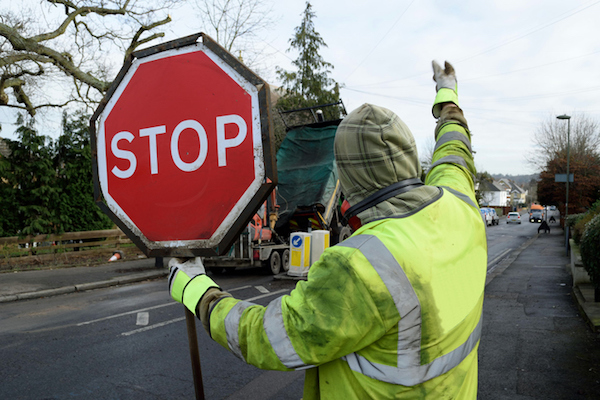By Pete Strickler
Multi-employer worksites, not surprisingly, can raise questions such as – when are you responsible for hazards affecting another employer’s workers? Or, what responsibility do other employers have for the safety of your workers?
Employees working for multiple employers on the same project, or in the same facility, are becoming more common. This is true especially in the construction and manufacturing industries, but also anywhere a work space is owned by one organization, but filled with multiple contractors, consultants and temporary workers employed in a variety of operations.
The Virginia Occupational Safety and Health Compliance Program (VOSH) can and will issue citations to one or more employers at a multi-employer worksite through its multi-employer citation policy. The policy describes the process for determining responsibility when more than one employer on a worksite might be citable under VOSH regulations.

VOSH will first categorize each of the relevant employers at a multi-employer worksite based on their respective roles: creating, exposing, correcting or controlling. A single employer may fall into more than one category. Once VOSH categorizes an employer, the agency will evaluate whether the employer met its obligations under VOSH requirements. If VOSH determines that the employer did not meet its obligations, the employer will be cited.
In situations where an employer’s own employees are not exposed to a hazard, that employer may still be subject to VOSH coverage if the employer qualifies as:
Creating Employer – The employer that caused a hazardous condition which violates a VOSH standard. Employers must not create hazardous conditions. An employer that does so is citable, even if the only employees exposed are those of other employers at the site.
Exposing Employer – An employer whose own employees are exposed to the hazard. If the exposing employer created the violation, the employer is citable for the violation as a “creating employer.” If the violation was created by another employer, the exposing employer is citable if it: a) knew of the hazardous condition or failed to exercise reasonable diligence to discover the condition (such as through self-inspections to routinely identify and address hazards); and b) failed to take steps consistent with its authority to protect its employees.
If the exposing employer has authority to correct the hazard, it must do so. If the exposing employer lacks the authority to correct the hazard, it is citable if it fails to do each of the following:
- Ask the creating and/or controlling employer to correct the hazard;
- Inform employees of the hazard;
- Take reasonable alternative protective measures. In extreme circumstances (e.g., imminent danger), the exposing employer is citable for failing to remove its employees from the job to avoid the hazard.
Correcting Employer – An employer whose own employees are exposed to the hazard. If the exposing employer created the violation, it is citable for the violation as a creating employer.
If the violation was created by another employer, the exposing employer is citable if it: a) knew of the hazardous condition or failed to exercise reasonable diligence to discover the condition (such as through self-inspections to routinely identify and address hazards); and b) failed to take steps consistent with its authority to protect is employees. If the exposing employer has authority to correct the hazard, it must do so.
If the exposing employer lacks the authority to correct the hazard, it is citable if it fails to do each of the following:
- Ask the creating and/or controlling employer to correct the hazard;
- Inform its employees of the hazard; and
- Take reasonable alternative protective measures. In extreme circumstances (e.g., imminent danger situations), the exposing employer is citable for failing to remove its employees from the job to avoid the hazard.

Controlling employer – An employer who has general supervisory authority over the worksite, including the power to correct safety and health violations itself or require others to correct them. Control can be established by contract, or in the absence of explicit contractual provisions, by the exercise of control in practice. A controlling employer must exercise reasonable care to prevent and detect violations on the site.
The extent of the measures that a controlling employer must implement to satisfy this duty of reasonable care is less than what is required of an employer with respect to protecting its own employees. This means that the controlling employer is not normally required to inspect for hazards as frequently or to have the same level of knowledge of the applicable standards or of trade expertise as the employer it has hired.
Standards with specific rules
Certain standards, listed below, have specific rules that address multi-employer worksites in both General Industry (1910) and Construction (1926).
- Hazard communication 1910.1200
- Lockout/tagout 1910.147
- Permit-required confined spaces 1910.146
- Process safety management 1910.119
- Frequent and Regular Inspections 1926.20(b)(2)
- Site Layout 1926.752
- GFCI’s, Stairways, Unprotected Sides or Edges 1926
Best practices
The following best practices will be helpful in controlling the hazards that contractors may pose.
- Prequalify your subcontractors by obtaining information concerning past citations, MOD rates, incident/accident rates and injury rates (specifically requesting the subcontractor’s VOSH 300 logs for the past three years).
- Create an orientation program for your subcontractors and their sub-subcontractors and point out known hazards in the area to the contractors.
- Provide an opportunity for all subcontractors to identify known hazards or hazardous situations they may create as a result of work they will be conducting.
- Document the due diligence you undertake to vet your subcontractors, train your subcontractors, inspect the jobsite, to establish safety plans and procedures, and to enforce safety rules.
- When drafting contracts, state that you reserve, request, or whatever wording your entity would chose, that you have the right to review the training and that it must meet certain standards.


